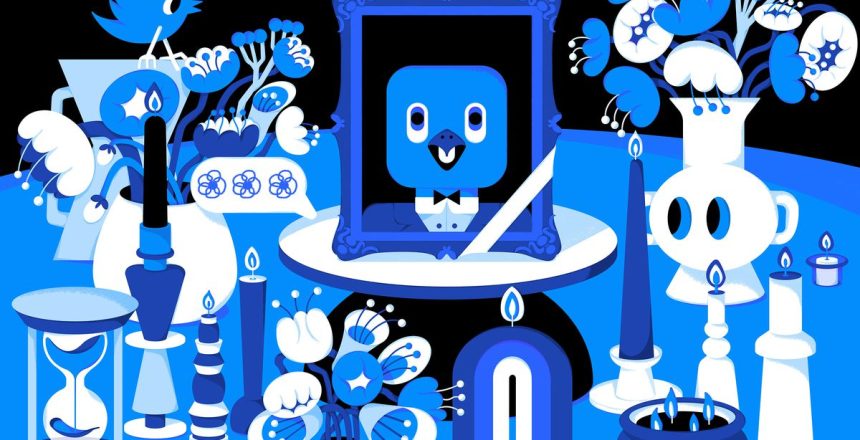/cdn.vox-cdn.com/uploads/chorus_asset/file/24539832/P12_RIP_Tweetbot_236587.jpg)
I had a corpse on my phone, and I kept checking in on it. Ever since January 12th, my preferred iOS Twitter app had been locked in stasis, frozen on an error modal informing me that “there was a problem authenticating with Twitter,” and wow, was there ever. Without any notice, Twitter had revoked the mainline access credentials for Tweetbot and every other third-party client not operated by Twitter itself.
Unlike many decisions made during Twitter’s “vox populi” Roman cosplay era, there had never been a poll about this. Elon Musk had never appeared deep in a thread with Kevin Sorbo and a spartan avatar burner account to say, “Yikes, third-party apps should go.” Instead, Twitter took several days to communicate with its users or commercial partners and admit that the move was deliberate, eventually releasing a “your fault”-style official tweet gnomically explaining that “Twitter is enforcing its long-standing API rules.”
All the while, I kept reopening this dead app on my phone, surfing on pure muscle memory
All the while, I kept reopening this dead app on my phone, surfing on pure muscle memory to the same error pop-up over the last post my timeline saw: a frozen Lord of the Rings GIF of King Théoden sneering, “You have no power here.” This app had been one of my primary ways of accessing Twitter for over a decade, so I was used to it making me feel powerless. But this repetitive ghost-swiping felt like a new low.
“You’re definitely not alone,” Paul Haddad reassured me, and I believed him because he co-created Tweetbot. “I know a lot of people who’ve had to delete it just to stop that from happening.”
This rictus state of pure interface had no other real exit. Yes, if I poked around a little, I could juke Tweetbot’s error protocols just enough to scroll through whatever slice of timeline it had loaded into memory right before the end. But the only reward there was getting to use Tweetbot’s well-honed tweet reading experience to endlessly review posts from January 12th. The pleasant haptic jolt I got from favoriting a mutual’s January 12th announcement that they’re “built like a worm” was a lie; it never registered. Without any ability to reauthenticate with Twitter, Tweetbot’s interface was all it had left.
This whole context, from Tweetbot’s error message to its short-term memory of cached content, was designed to be ephemeral, just something you’d see when your signal cut out or if Twitter itself went down.
“Certainly we had to deal with outages in the past, the whole Fail Whale era,” Haddad said. “We definitely didn’t think this is how it would end.”
Nobody does a product design sprint on how their app should behave in the event that it unexpectedly no longer exists.
Nobody does a product design sprint on how their app should behave in the event that it unexpectedly no longer exists
Haddad’s three-person company, Tapbots, handled all of this as gracefully as one could expect anyone to handle a straightforward attack on their livelihood. Ten or so days after the app had its plug pulled, the team issued a stout elegy for their creation, without flinching from saying that they’d “invested over 10 years building Tweetbot for Twitter and it was shut down in a blink of an eye.” Tapbots’ tribute joined sentiments from its heartbroken superusers, who’d happily paid a few bucks per year for access to its artisanal iconography and expertly rounded corners. (“One of the very best apps I’ve ever used,” eulogized Apple ultra-blogger John Gruber.) Like many other Twitter members disappointed by the company’s mercurial policymaking and ego-driven roadmap, Tapbots surveyed the wreckage and chose to migrate. With a grim but dignified paragraph break, Tapbots announced a new focus for the company: Ivory, a fledgling Mastodon client built on all it had learned from creating Tweetbot as well as much of its code.
As a longtime Mastodon account holder who nonetheless still feels like a rookie on the platform, I’m happy to see Tapbots taking its talents to the Fediverse’s loosely joined scatterplot of social islands. The experience of joining Mastodon really depends on which server you start out on — the particular people you associate with Twitter have already dispersed, if they’re here yet at all. A tool like Fedifinder or Debirdify will yield a tidy data payload you can use to bulk-follow individuals where they’ve landed, but they might also be spread across two dozen servers. Part of Twitter’s double helix of horror and intrigue was that everyone swam in the same pool — you and your weird pals and Russian disinfo forces and Shaq. On Mastodon, every server has its own culture, and you can only join one server per account, so there’s a bit of a sense that everyone’s playing to a slightly different room. Installing Ivory for the first time, I felt some hope that a little familiarity might go a long way.
Having now used Ivory for several months, I can say that, while Mastodon isn’t much like Twitter, Ivory at least feels like Tweetbot, and that’s been enough to give the whole experience a comforting gloss that has, in turn, helped me embrace Mastodon. I asked Haddad if this was intentional. “That’s been one of our goals,” he told me, “to make it as easy and transparent as possible. Obviously Twitter and Mastodon are two different things, but to be honest, I like Twitter.” He paused to correct himself. “Well, I liked Twitter.”
“Obviously Twitter and Mastodon are two different things, but to be honest, I like Twitter… Well, I liked Twitter.”
This wasn’t just a comment on regime change. Haddad keyed in on how Twitter used to feel, especially in its earlier pre-algorithmic feed days. “A simple social network where people post and reply to each other. I didn’t think there was anything wrong with it back then, I don’t think there’s anything wrong with it now, and if we can provide that experience, I’m more than happy to do it,” he said. Focusing on a classic Twitter flavor does require some sacrifices at this early stage. Ivory doesn’t let you muck too much with Mastodon’s decentralized nuances, for example; you can’t use it to explore servers you haven’t joined or browse the social graphs of interesting people in other communities. The most prominent view Ivory offers is a simple timeline from the accounts you’ve specifically followed. You can also browse the Local server you joined or branch out to a broader and more chaotic Federated feed, all with the same smooth-scrolling action as Tweetbot because (as Haddad confirmed) it’s literally the same scroll-handling function. Ivory, at least in this infant form, gets you comfortable by reducing Mastodon’s multidimensional possibility space into simple 2D feeds that fit a well-established frame.
Tapbots makes what I would call “opinionated software,” which is a tricky phrase to throw around because it can be complimentary or backhanded depending on context. But the idea is that simply dumping every possible function of a Twitter or Mastodon at a user’s feet like a bin of Legos isn’t actually helping them use it successfully. “One thing I don’t like to do, and it’s hard to get away from it, is have a million settings in the app,” said Haddad, confidently accepting my opinionated software label. “We try very hard to keep the number of settings down to minimize it to only the things that are really important, and then just make things work as automatically as possible.”
This kind of taste-driven dance leading can help bring the ideal form of a platform into focus as it evolves
Tweetbot came to prominence by having opinions about the best way to respond to tweets (with a friendly but deliberate swipe) or to boost them (tapping once to expose likes and retweets, again subtly nudging you to reconsider). These learned behaviors aren’t necessarily obvious at first, even if they eventually become second nature enough to introduce the kind of compulsion that inspired this piece — and Tweetbot’s orientation toward multitouch virtuosos probably left some growth on the table. Tapbots also made some firm edits to the Twitter experience. You had to swipe into a tweet to see its stats, for example, exactly the kind of decision you’d never see in an official Twitter app optimized for an endless flywheel of engagement. Deployed skillfully, this kind of taste-driven dance leading can help bring the ideal form of a platform into focus as it evolves, and the still-burbling primordial soup of Mastodon stands to benefit.
When I talked to Haddad, I didn’t feel like I was talking to someone still in the throes of grief. He and Tapbots have accepted the casual destruction of a decade’s work and salvaged the best parts into a new chapter for the company.
“Now that we’re out, it’s kind of interesting just to not have to worry about Twitter stuff anymore,” Haddad said. “I’m just chilling out and seeing what the latest nonsense is.”
I asked Haddad if he still had Tweetbot on his phone, and if so, which tweet it had frozen on after the extinction event.
“Let me see,” he said, swiping a bit, frowning at his screen. “Maybe I did delete it,” he ventured gently. He swiped some more. “No, I did not delete it… Oh.”
Haddad stopped.
“The very last tweet, believe it or not… Elon Musk.” He sent me a screenshot.
“Instagram makes people depressed & Twitter makes people angry,” Musk had mused, minutes before Haddad’s own post about Tweetbot going silent for the last time. Twitter’s chief rake-stepper ended his tweet with a question, “Which is better?”
For Tapbots, it’s clearly Mastodon, where it can once again build its product its way — and remind Elon Musk: you have no power here.





